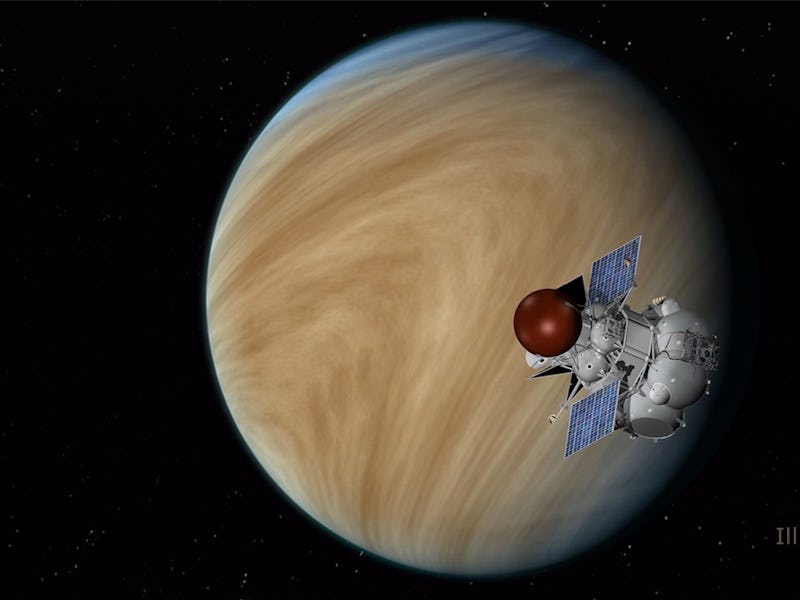Can a Mission to Venus Save America and Russia’s Space Romance?
In space, no one can hear love die.

America’s and Russia’s partnership in space travel and exploration has severely deteriorated over the last decade, and the only thing that may be holding it all together is a zany idea for a robotic mission to Venus from both orbit and on the ground.
Could the yellow planet boasting surface temperatures of 500-degrees Celsius and 90 times the pressure of Earth really be the glue that saves the NASA-Roscosmos marriage from completely falling apart?
If you’re not already caught up to speed, here’s the deal: after the United States beat Russia to the moon, NASA and Russia’s Federal Space Agency (the precursor to the state-run corporation Roscosmos) began to enjoy several decades of productive collaborations, culminating in the two countries leading the completed construction and operation of the International Space Station in 2000. For most of the last 17 years, the ISS, along with other projects, has been a source of healthy cooperation, even when international politics on the ground seemed to threaten broader relations between the U.S. and Russia.
That relationship recently nosedived. The schism between the U.S. and Russia reached a pitch in just this past year, and the U.S. has been rushing to wean itself off of Russia for its space fix. NASA’s Commercial Crew Program — which will use Boeing and SpaceX launch vehicles as a way to get U.S. astronauts to the ISS — is touted as the solution to ensure the country no longer has to buy tickets to space on Russian Soyuz launches. Blue Origin and others are working on American-made rocket engines so the U.S. doesn’t have to buy them from Russia.
And more critically, Russia itself doesn’t seem to interested in keeping this relationship alive. The country is basically done with the ISS after next year. It has a few more projects it’s working on with others, but that’s about it. Russia seems content to go solo in space after 2018.
Which brings us to Venera-D, a proposed 2025 mission between NASA and Roscosmos scientists to send an orbiter, lander, and potentially an unmanned glider to Venus to study the planet’s surface and atmosphere for potential signs of life, ancient and current.
Venera-D has a better potential than any Venusian mission before it to really investigate the second planet from the sun and augment our understanding of how it came to be the ungodly hell it is today. The new spacecraft and lander design would be fitted with new kinds of technology that could be capable of withstanding the extreme pressures and temperatures of the surface, and make use of the planet’s winds and turbulence to help navigate itself. The orbiter would be expected to last for about three years; the lander, for just a few hours (though much longer than previous Venusian landers); and the glider for potentially more than a year.
This week, Russian and NASA-sponsored scientists are set to meet to go over a refined version of Venera-D, soon after a report from the Venera-D team was submitted earlier this year. If the meeting goes well, we might finally have a mission that the countries are eager to move forward with.
For now, it’s far from clear if Venera-D will get funding. As opposed to Mars, there’s no possibility of inhabiting Venus in the foreseeable future. We’re also far from being able to collect any useful resources from the planet. Any mission designed to make the journey over there would be strictly for science.
NASA isn’t exactly throwing around money these days. The specter of potential budget cuts imposed by the Trump presidency still looms, and what money is already being discussed is meant to focus efforts on Mars missions.
Meanwhile, Russia seems to be revving up its resources towards finishing up old business: a trip to the moon. It’s got its own plans for human exploration, and they’re pretty well separate from NASA’s — at least for now.
Yet Venus remains an extremely enticing target for exploration. Though the planet is a deathly landscape for any current notion we have of life, it wasn’t always this way. It may have been habitable long ago — and understanding the planet in greater detail could reveal more about the kinds of ingredients that go into making a planet a home to living things.
There’s also the prestige that would go with pulling off such a challenging mission. The most time any spacecraft has survived the surface of Venus was 127 minutes, when the Soviet Union’s Venera 13 landed on the planet in 1982. Getting any piece of technology to stay operational on Venus for more than a couple hours would be a monumental feat. It would be a sign of sheer technological prowess, illustrating that that country is probably capable of building terrestrial devices just as impressive.
If Venera-D is approved, with participation from the U.S. and Russia, even that might not be enough to save the once-great space romance. Still, it would be a nostalgic throwback to a time when space was a source of peace and friendship between the two countries. There’s certainly some value in that.